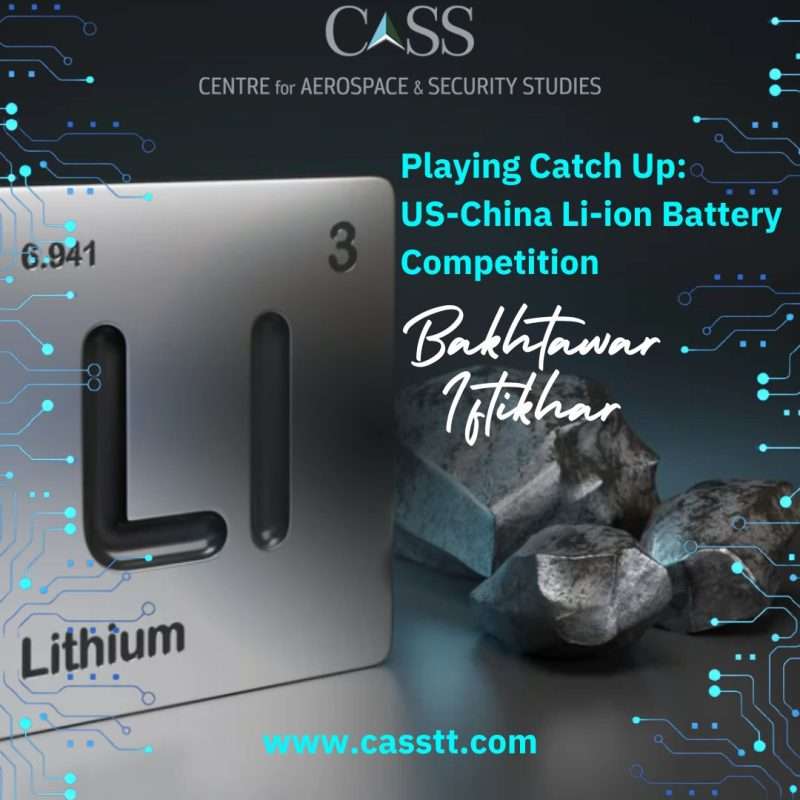As the world struggles to decouple from fossil fuels under the umbrella of a green future, the demand for critical minerals is increasing. The clean technology industry, like many others, relies upon critical minerals or ‘Rare Earth Elements’ extracted from the ground. Lithium is one such metal critical for electric rechargeable batteries heavily used in Electric Vehicles (EVs) and electrical grid storage. It is also perceived as ‘a strategic commodity that could contribute to energy independence.’ This discussion narrows in on one of the most critical aspects of this issue: the challenges faced by the United States and China’s emerging dominance in the lithium battery sector, and the broader implications of this dynamic for the green transition; and how developments in these states are shaping the landscape of global renewable energy and environmental policy.
Market dynamics vary from mineral to mineral, but in the case of lithium, the US has had a few domestic shortcomings. Despite its significant lithium reserves of 9.1 million tonnes, the US only has one operational lithium mine at Silver Peak, Nevada. Moreover, domestic refining and processing activities have been stagnant. A ‘lack of industrial policy and national strategy’ is cited as one of the weaknesses in an analysis of the US position in global battery manufacturing. Meanwhile, Beijing dominates the lithium-ion battery supply chain. China is the only state with the capacity to ‘process lithium from raw material to finished batteries without having to rely on imported chemicals or components and six out of the biggest EV-battery producers are based in China.’ Hence, in the last decade, the burgeoning EV market has inevitably led the US to rely heavily on imports, particularly from China. This dependence is especially evident in the market for lithium-ion (li-ion) batteries. In the first quarter of 2023, a staggering 87.9% of US li-ion battery imports originated from China. This trend is not new, though as in 2022, the US spent USD 9.3 billion on li-ion battery imports, predominantly from China. While other sources like South Korea and Japan do contribute to the US import market, their shares are relatively minor when compared to China’s dominant role.
With anti-China sentiment growing in Washington, China’s dominance in the lithium-ion battery market is seen as a threat to the United States’ quest for technological supremacy. Beyond geopolitical rivalry, there’s a palpable concern about serious supply risks, should this dominance be leveraged strategically. A historical precedent heightens these fears: in 2010, during a dispute over the Senkaku Islands, China reportedly ceased rare-earth exports to Japan. Consequently, the US is wary of potential scenarios of China ‘throttling supply or dramatically raising prices.’ Such actions would have profound repercussions on the American transportation and logistics sectors, disrupting critical supply chains.
Given these challenges, the Biden Administration has recognised the need to secure supply. US Senators have called for developing a strategic rare-earth reserve by 2025 via stockpiling critical minerals, including lithium, but doing so in an ‘environmentally-sustainable’ manner since the common mining processes pose significant environmental risks. In addition, the Pentagon also recognises the need for stockpiles under the pretext of its apparent aim of zero-emissions and the need for lithium-ion batteries in weaponry such as Raytheon Technologies Corp’s precision-guided munitions.
Re-invoking Cold War-era’s Defence Production Act in 2022, Biden planned to take a mineral-by-mineral approach to ramp up domestic production. The American Battery Material Initiative intends to produce enough ‘battery-grade lithium to supply around 2 million EVs’. This would be supplemented by offering tax credits and incentives to companies using ‘minerals and battery components from US and its allies.’
At the same time, the US is attempting to exclude China from its supply-security initiatives. For example, a draft document by the US Department of Energy establishes an eligibility criteria for the subsidies being offered and excludes Foreign Entities of Concerns, i.e. ‘any company more than 25 per cent owned by Chinese, shareholders’. Externally, the US will diversify supply by rallying support from states other than China through the Mineral Security Partnership. Thus, these measures collectively demonstrate the Biden Administration’s ambition to catch up with China in the rare-earths domain.
However, the current US approach may create a detrimental impact on the global community at large. It could further fuel US-China tensions and impede collaboration between these two nations at a time when unified action is crucial, particularly in addressing the imminent threat of climate change. China’s advancement in battery technology not only underscores its role as a key player in the climate change battle but also highlights its potential to facilitate a worldwide transition to EVs. Leveraging China’s comparative advantage in battery production could be instrumental in this global shift, underscoring the need for cooperative rather than confrontational international relations. Therefore, the world would benefit from the two superpowers engaging responsibly with one another and cultivating a coordinated response.
To conclude, an imperial competition for resources should not overshadow a collective commitment to the green agenda. Power play between geopolitical rivals must not come at the cost of the intricate ecological balance that has been established over millennia.
Bakhtawar Iftikhar is a Research Assistant at the Centre for Aerospace & Security Studies (CASS), Islamabad, Pakistan. She can be reached at [email protected].
Design Credit: Mysha Dua Salman





